Topology Identification of Low-Voltage Power Lines Based on IEC 61850 and the Clustering Method
Abstract
:1. Introduction
2. The Representation of Low-Voltage Line Topology
2.1. Mathematical Description Based on Graph Theory
2.2. The Mathematical Model of Line Topology Identification
3. Line Topology Analysis
3.1. Structure of Low-Voltage Line Topology
3.2. Voltage Data Analysis for Low-Voltage Station Area
4. Full Topology Identification Strategy
4.1. The Division Method of the Region
- (1)
- Missing line segment from station area transformer (the area where Figure LTU2 is located). It is known that the meter layer of this station’s shutdown area contains two meters of information, and the identified line topology information contains only one station area transformer, so it was judged that the topology information of this area was missing.
- (2)
- The branch node region was missing (the region where LTU3 is located in Figure 5). When using the injection method for inter-region line topology identification, if S3 is disconnected, LTU1, LTU5 and LTU6 can all be identified to receive signals. Based on the IEC 61,850 SCL configuration information, the line topology within the region can be obtained and, combined with the signal awareness information, it can be seen that there is no line connection between the line topologies of LTU1, LTU5 and LTU6, so the branch node region was judged to be missing.
- (3)
- The leaf node area was missing (the area where LTU6 is located). Missing or not, the installed LTU can cause the leaf node area to be missing. Based on the SCL configuration information of IEC 61850, it is known that the branch node area contains outgoing line information, but no leaf node area contains incoming line information; therefore, it was judged that the leaf node area downstream of this branch node area was missing.
- (4)
- Multiple regions were missing. This includes the root node region and branch node region disappearing at the same time, or the root node region and leaf node region disappearing at the same time, or the branch node region and leaf node region disappearing at the same time. If LTU3 and LTU6 are missing at the same time, it is known from the configuration information of LTU1 that it contains two outgoing lines; however, there is no branch node region containing the same incoming line information, so it was judged that the branch node region and the leaf node region were all missing.
- (5)
- The full domain was missing. If the full domain does not contain an LTU, the distribution transformer supervisory terminal unit (TTU) does not store the line topology configuration information related to the station area. However, according to the electricity collection system, the area contains a large number of electricity users, so it was judged that all of this area was missing.
4.2. Topology Identification Combination Strategy
5. Region Topology Identification Method Based on IEC 61,850 SCL
- (1)
- Initiate topology identification in the station area. The smart gateway sends topology identification commands to the associated LTU via communication., by injecting characteristic currents at the end user/power source.
- (2)
- The associated LTU detects whether the characteristic current flows. If the end user injects characteristic current at the LTU3 of the meter box, the characteristic current can be detected at LTU3, LTU2 and LTU1.
- (3)
- LTU uploads the detection results and configured IED description (CID) file to the smart gateway. For example, LTU3–LTU2–LTU1 are located on the same line. Similarly, LTU4–LTU2–LTU1 are located on the same line. According to the BFS algorithm, the upstream and downstream connection relationship of the platform area is LTU1–LTU2–LTU3–LTU4–LTU5.
- (4)
- The smart gateway analyzes the CID file sent by the LTU, which can be known based on the IEC 61,850 SCL regional topology, and generates the topology file of the station in combination with the upstream and downstream connections of the station area.
6. Topology Identification of Unknown Region Based on K-Means Clustering
6.1. Region Topology Identification Based on K-Means Clustering Algorithm
- (1)
- Set the number of clustering. Assuming that the sum of the unrecognized regions is s, the clusters that need to be clustered are:
- (2)
- Select initial clustering centers. The voltage data of each node upstream of the missing region is taken as the initial clustering centers. Let be the set of voltage sequences in the missing region and be the set of voltage sequences in initial clustering centers.
- (3)
- Data correlation analysis. By introducing the correlation coefficient , which describes the consistency of the voltage data in the region to be identified with the fluctuation of the voltage data in the initial clustering centers, the expression is shown below, where, z is the data dimension of the sample, which can be obtained by the product of sampling frequency and sampling time. , , is the unit vector, and are data sets of dimension n, respectively, and and are data of dimension r, respectively. The transpose of is .
- (4)
- Center of clustering reset. The class is divided according to the correlation coefficient, and the mean centroid is calculated as the new centroid. The correlation coefficients are shown in Table 2 below.
- (5)
- Threshold judgment. Determine whether the correlation coefficient between the centroid and sample voltage data were greater than the threshold value (0.8 was selected in this paper). If not, repeat (3) and (4); if not, end the algorithm.
6.2. Case Analysis
7. Discussion
- (1)
- This paper drew on the configuration scheme of a medium-voltage distribution network based on the IEC 61,850 standard, and configured the line topology of a low-voltage distribution network based on the IEC 61,850 SCL, which is conducive to the information integration and sharing of MV and low-voltage distribution networks, and more conducive to the realization of the monitoring of low-voltage distribution networks.
- (2)
- The clustering analysis only targets unknown regions, which greatly reduces the amount of data and avoids wasted resources, making it more suitable for application in intelligent terminals of low-voltage distribution networks with limited resources. The accuracy of similarity judgment was improved by using the branch node with a closer electrical distance as the center of the clustering, subphase line clustering, etc.
- (3)
- The full topology identification strategy proposed in this paper improves the accuracy of line topology identification by targeting different line topology identification strategies to the specific situation of line topology in the station area. After experimental analysis, the accuracy of identification was higher for the method in this paper compared with the topology identification of the whole station area using only clustering algorithm. It facilitates the use of other advanced applications in the distribution network, and is of great significance to improve the monitoring of low-voltage distribution networks and ensure the safe electricity consumption of end users.
- (4)
- The impact of the DER is mainly the uncertainty and randomness of the power output, which will cause the voltage of the same line to fluctuate together. The article method can be identified in this scenario, but due to the unsynchronized sampling data at each point, it will affect the identification results, and this problem will continue to be studied later.
Author Contributions
Funding
Data Availability Statement
Conflicts of Interest
Appendix A
References
- Pappu, S.J.; Bhatt, N.; Pasumarthy, R.; Rajeswaran, A. Identifying Topology of Low Voltage Distribution Networks Based on Smart Meter Data. IEEE Trans. Smart Grid 2017, 9, 5113–5122. [Google Scholar] [CrossRef]
- Hosseini, Z.S.; Khodaei, A.; Paaso, A. Machine Learning-Enabled Distribution Network Phase Identification. IEEE Trans. Power Syst. 2020, 36, 842–850. [Google Scholar] [CrossRef]
- Soltani, Z.; Khorsand, M. Real-Time Topology Detection and State Estimation in Distribution Systems Using Micro-PMU and Smart Meter Data. IEEE Syst. J. 2022, 16, 3554–3565. [Google Scholar] [CrossRef]
- Zhu, Z.Y.; Xu, B.Y.; Brunner, C.; Yip, T.; Chen, Y. IEC 61850 Configuration Solution to Distributed Intelligence in Distribution Grid Automation. Energies 2017, 10, 528. [Google Scholar] [CrossRef]
- Chen, Y.; Sun, L.; Wang, Z.; Wang, J. Distribution Network Topology Identification Based on IEC 61850 Logical Nodes. Sci. Program. 2021, 1, 1–8. [Google Scholar] [CrossRef]
- Zhu, Z.; Xu, B.; Brunner, C.; Guise, L.; Han, G. Distributed topology processing solution for distributed controls in distribution automation systems. IET Gener. Transm. Distrib. 2017, 11, 776–784. [Google Scholar] [CrossRef]
- Zhong, J.Y.; Xiong, X.F.; He, Y.C.; Shan, R.R.; Jiang, H.L.; Li, S.Q. Plug-Play and Topology Identification Method for Intelligent Terminal in Distribution Station Area. Autom. Electr. Power Syst. 2021, 45, 166–173. [Google Scholar]
- Ma, B.Y. Overview of Topology Identification Methods for Low Voltage Stations. Mod. Inf. Technol. 2021, 5, 71–77. [Google Scholar]
- Wang, R.N.; Wu, Y.; Wei, H.M.; Wang, C.W. Topology identification method for a distribution network area based on the characteristic signal of a smart terminal unit. Power Syst. Prot. Control 2021, 49, 83–89. [Google Scholar] [CrossRef]
- Ge, H.T.; Xu, B.Y.; Zhang, X.H. Low-Voltage Overhead Lines Topology Identification Method Based on High-Frequency Signal Injection. Arch. Electr. Eng. 2021, 770, 791–800. [Google Scholar]
- Zhang, R.X.; Ma, Z.B.; Qian, C.W.; Hou, Z.F. Model and Algorithm of Automatic Identification of Substation Area Topology Based on Metering Data. Distrib. Util. 2021, 38, 73–79. [Google Scholar]
- Li, C.C.; Fan, X.Z.; Wang, Q.; Du, Y.; Zhu, H.X.; Yu, C. Station area recognition of distribution network based on electricity information acquisition system. Electr. Meas. Instrum. 2019, 56, 109–114. [Google Scholar]
- Hu, X.Z.; Cong, W.; Gu, Q.S.; Hu, C.H.; Wang, K.C. Topology identification method for low-voltage power supply network based on meter measurement data. Electr. Power Autom. Equip. 2022, 1–17. [Google Scholar] [CrossRef]
- Chen, Z.A.; Huang, C.; Zhang, Z.D.; Jiang, Y.Q. Topology identification method of a low voltage distribution network based on T-type grey correlation degree and KNN algorithm. Power Syst. Prot. Control 2021, 49, 163–169. [Google Scholar]
- Guo, S.H.; Wang, G. Topology identification and monitoring of low-voltage distribution network based on multi-granularity clustering and multivariate characteristic statistics. Electr. Power Autom. Equip. 2022, 1–13. [Google Scholar] [CrossRef]
- Feng, R.H.; Zhao, Z.; Xie, S.; Huang, J.L.; Wang, W. Topology Identification for Low Voltage Network Based on Principal Component Analysis and Convex Optimization. J. Tianjin Univ. (Sci. Technol.) 2021, 54, 746–753. [Google Scholar] [CrossRef]
- Cai, Y.Z.; Tang, J.; Wei, F.S.; Li, J.; Guo, W.C.; Yang, Y.; Liu, S.L. Phase Sequence Recognition Method of Station Area Based on Random Forest Algorithm. Mech. Electr. Eng. Technol. 2021, 50, 227–230. [Google Scholar]
- Liao, Z.W.; Xie, X.K.; Zheng, G.Y.; Wang, B.W.; Liu, Y. Phase Identification of Low-voltage Distribution Area Based on Morphological Characteristic Clustering of Voltage Curves. Autom. Electr. Power Syst. 2022, 1–11. Available online: http://kns.cnki.net/kcms/detail/32.1180.TP.20221101.1658.004.html (accessed on 5 November 2022).
- Song, Y.Z. Research on Fast Topology Identification Based on Graph Theory; North China Electric Power University: Baoding, China, 2010. [Google Scholar]
- Yang, H.C.; Wang, X.D.; Shi, Z.P.; Wang, J.M.; Chen, K.; Wu, H. Research on Household Variation Relation and Phase Recognition Technology of Low Voltage Distribution Network Based on Voltage Similarity Assessment. Electr. Meas. Instrum. 2022, 1–6. Available online: http://kns.cnki.net/kcms/detail/23.1202.TH.20210727.1302.002.html (accessed on 3 June 2022).
- Tang, J.; Cai, Y.Z.; Li, Q.L.; Liu, S.L.; Zhang, Y.J.; Yi, Y.Q.; Huang, X.M. Phase Sequence Identification Method for Users in Low-voltage Distribution-station Area Based on Feature Constraint Clustering of Three-phase Meter. Autom. Electr. Power Syst. 2022, 46, 60–67. [Google Scholar]
- Yang, Z.C.; Shen, Y.; Yang, F.; Le, J.; Su, L.; Lei, Y. Topology identification method of low voltage distribution network based on data association analysis. Electr. Meas. Instrum. 2020, 57, 5–11. [Google Scholar]
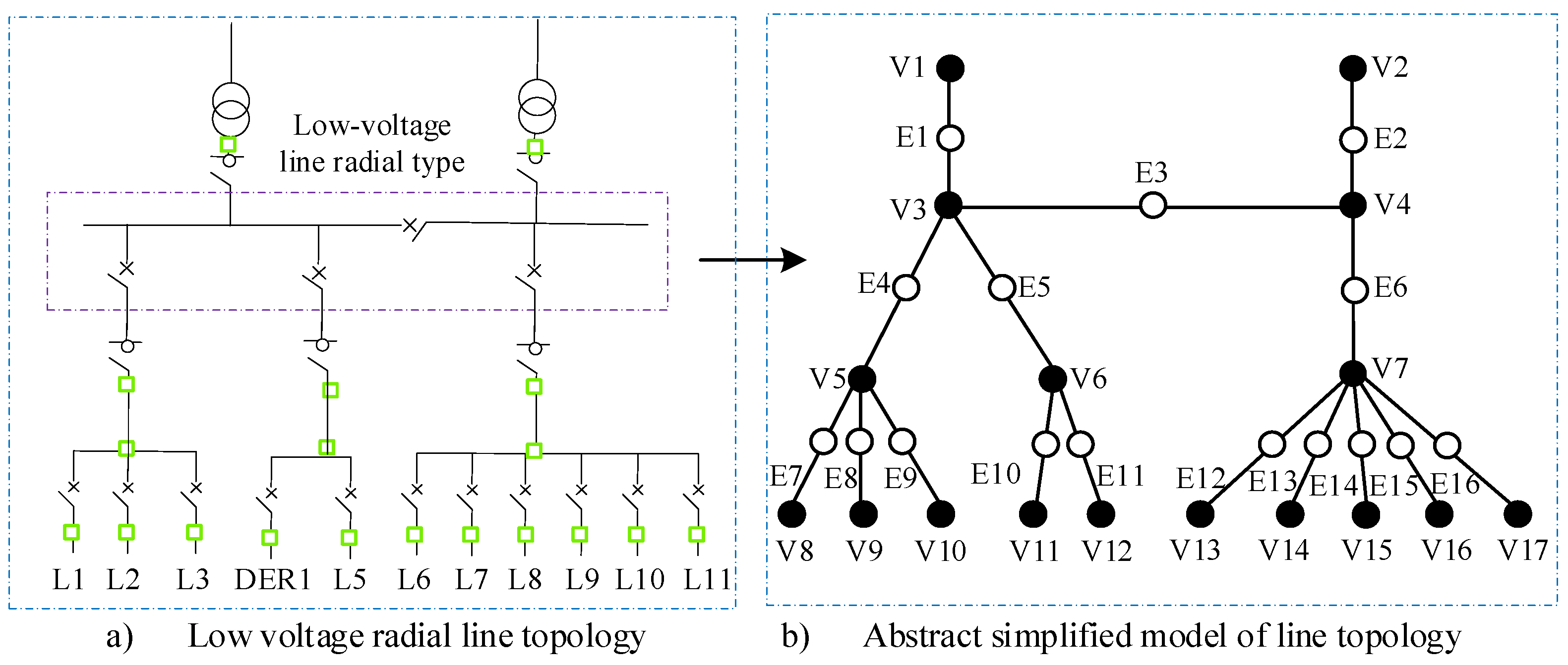





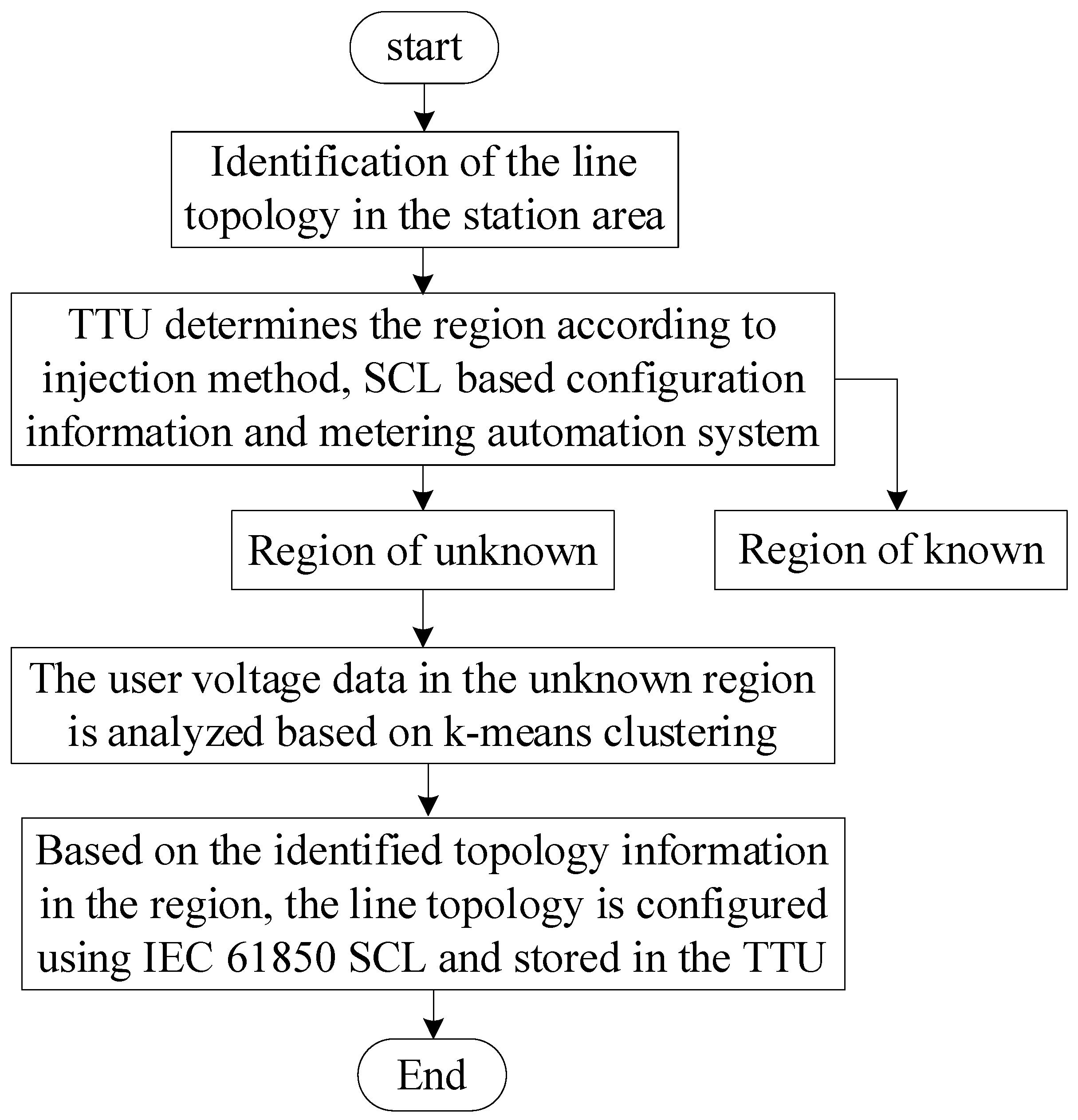
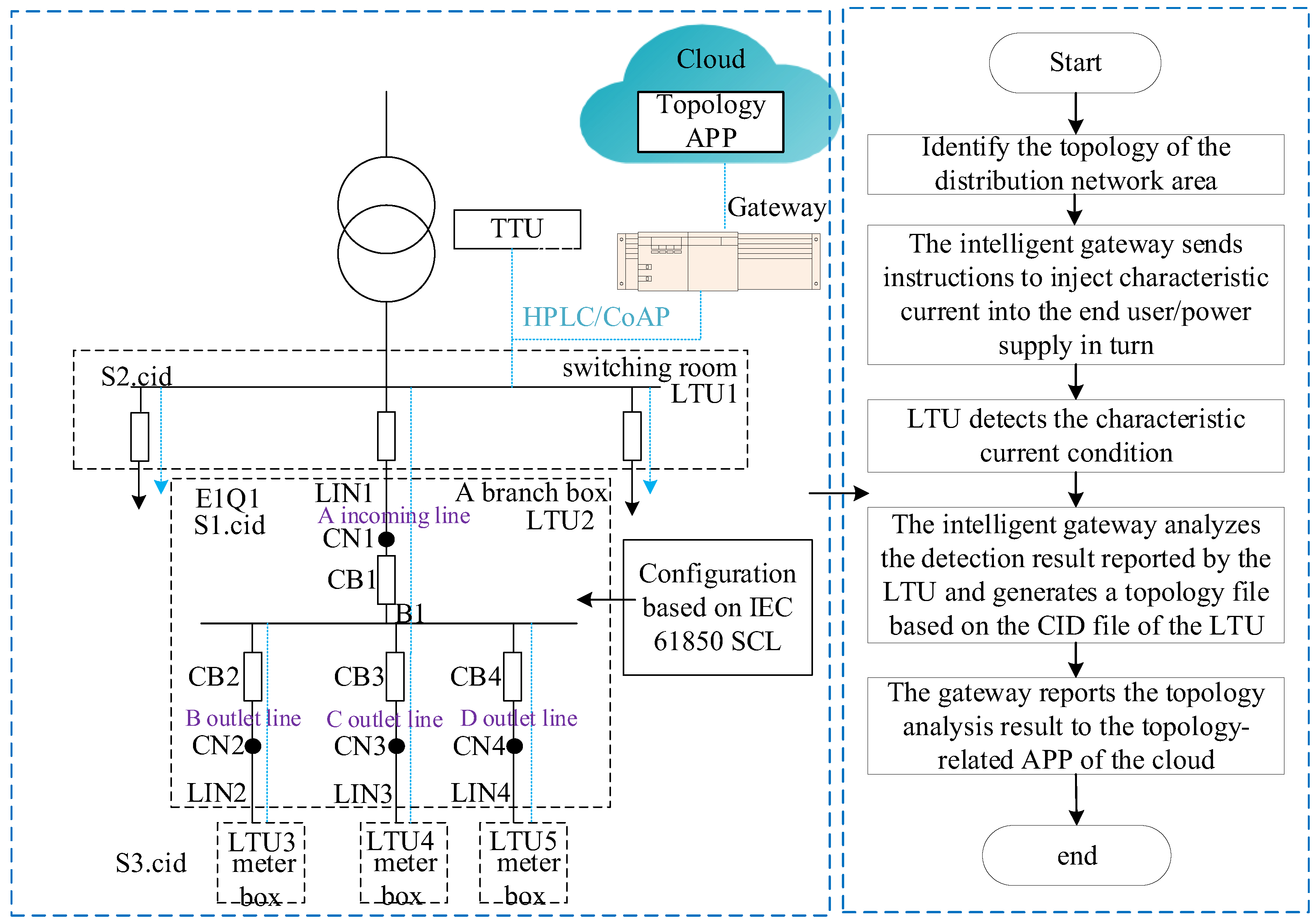
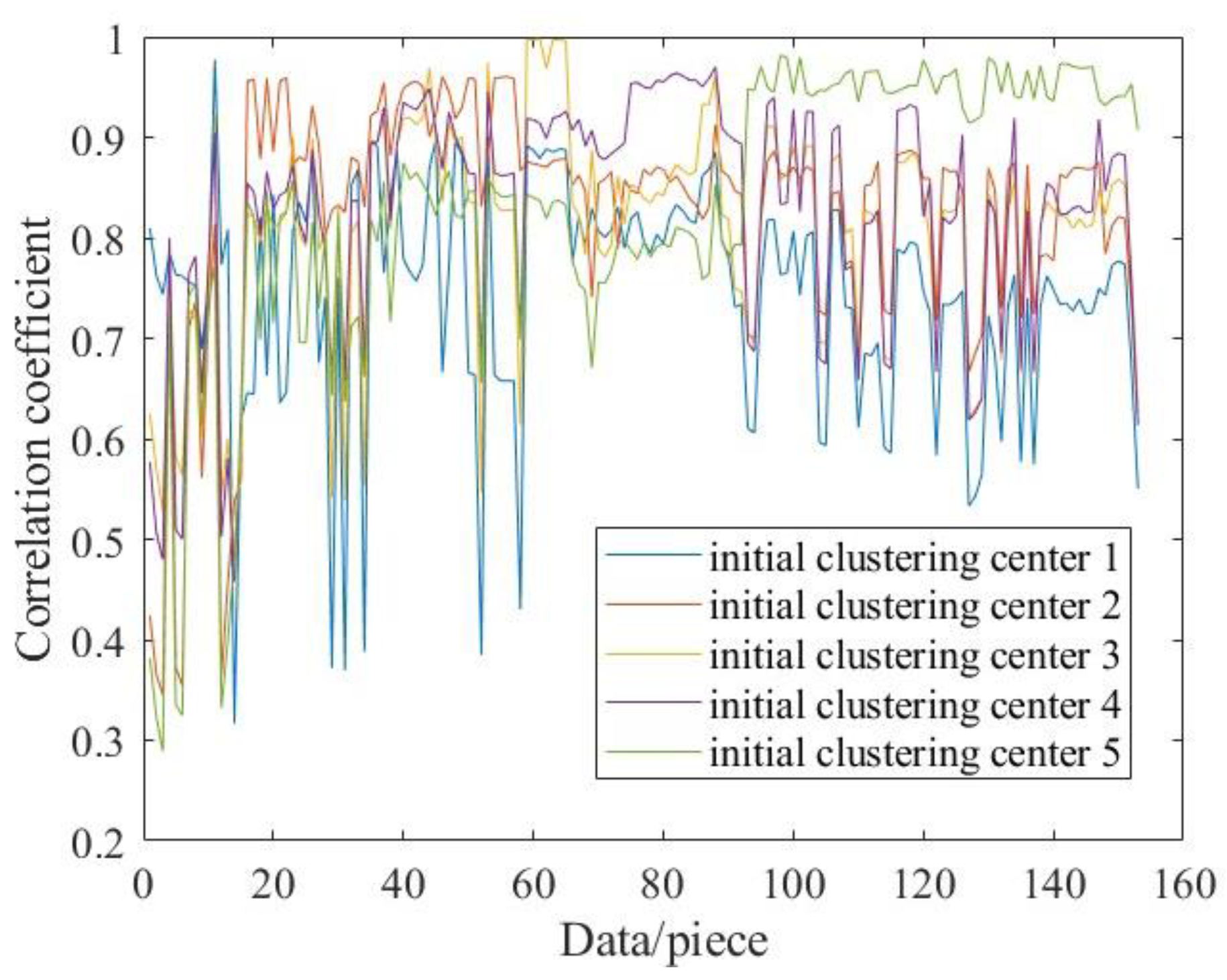
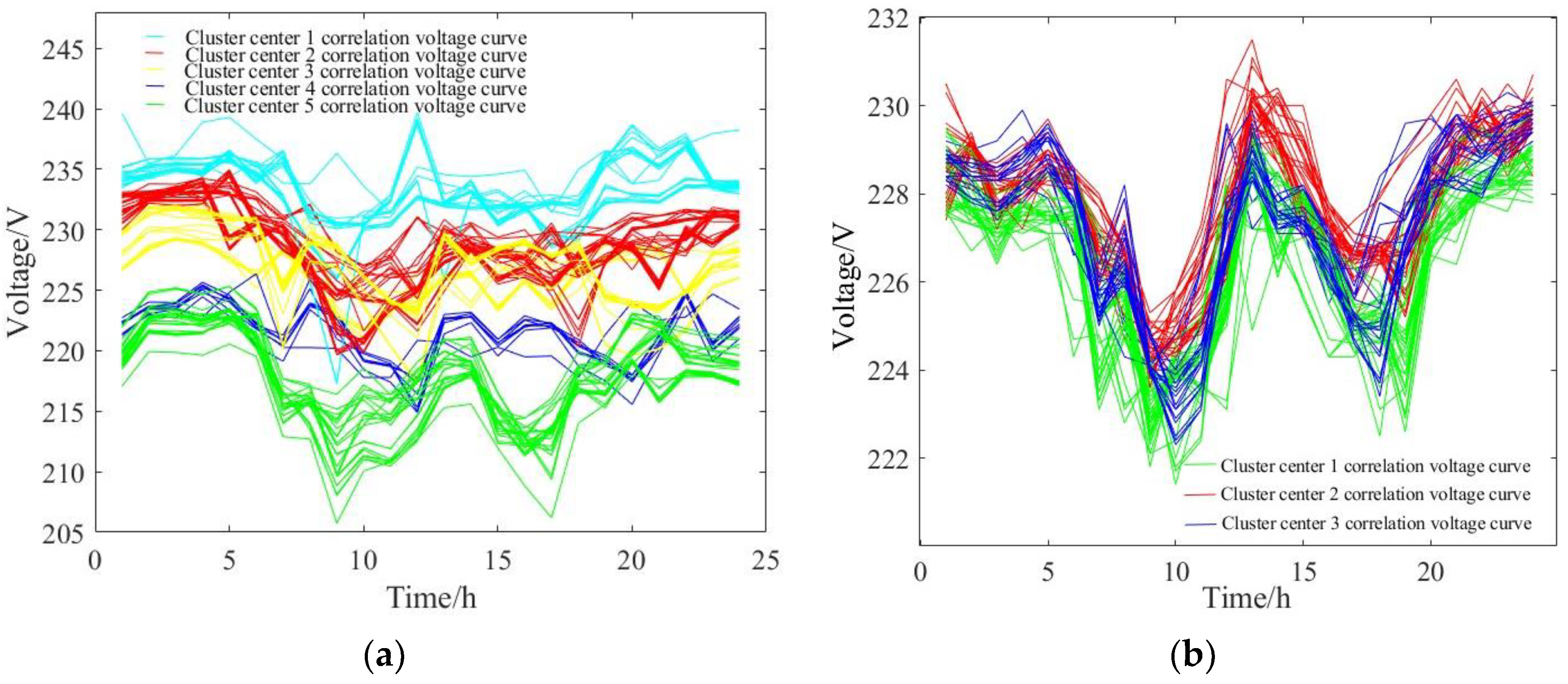
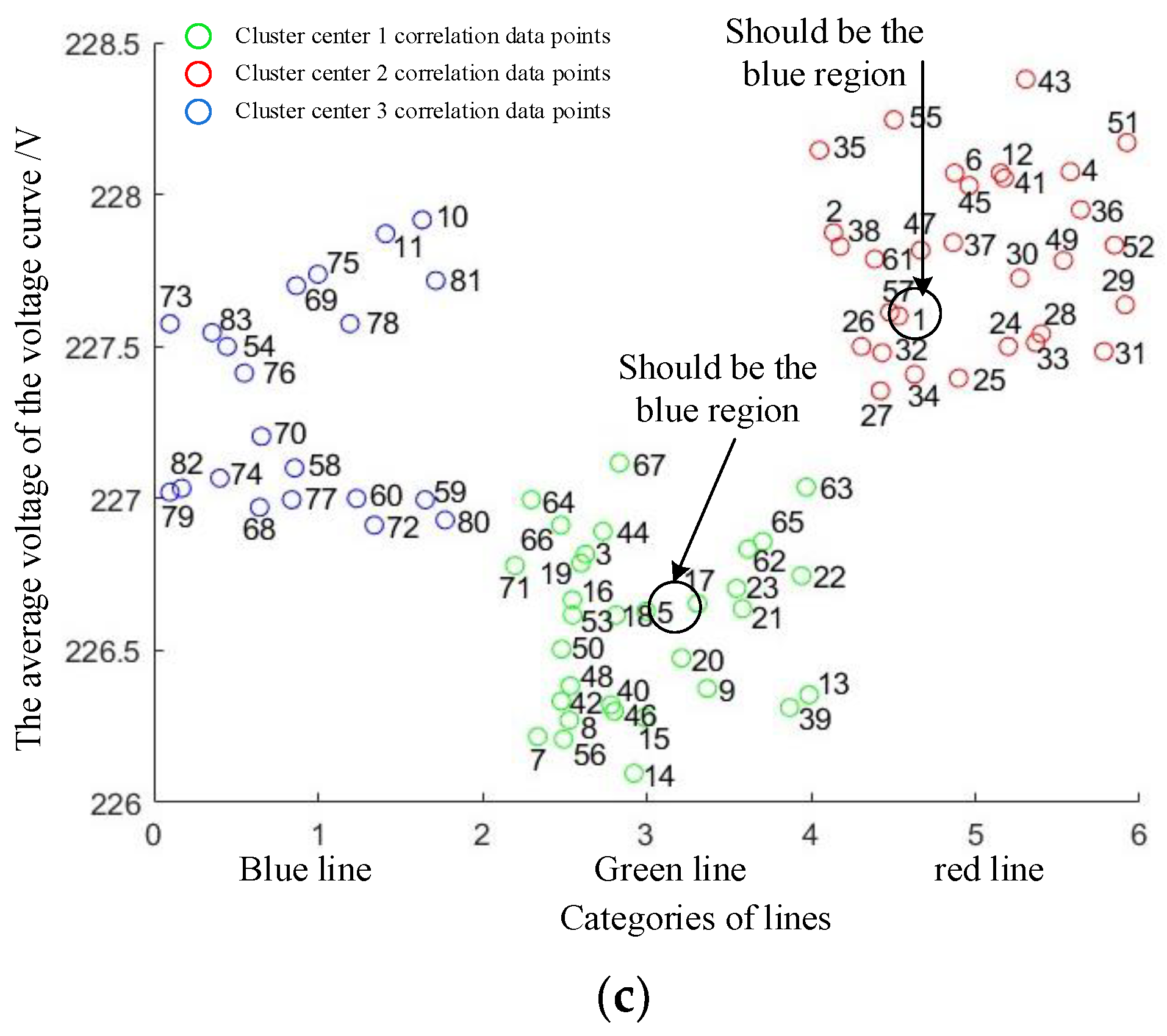
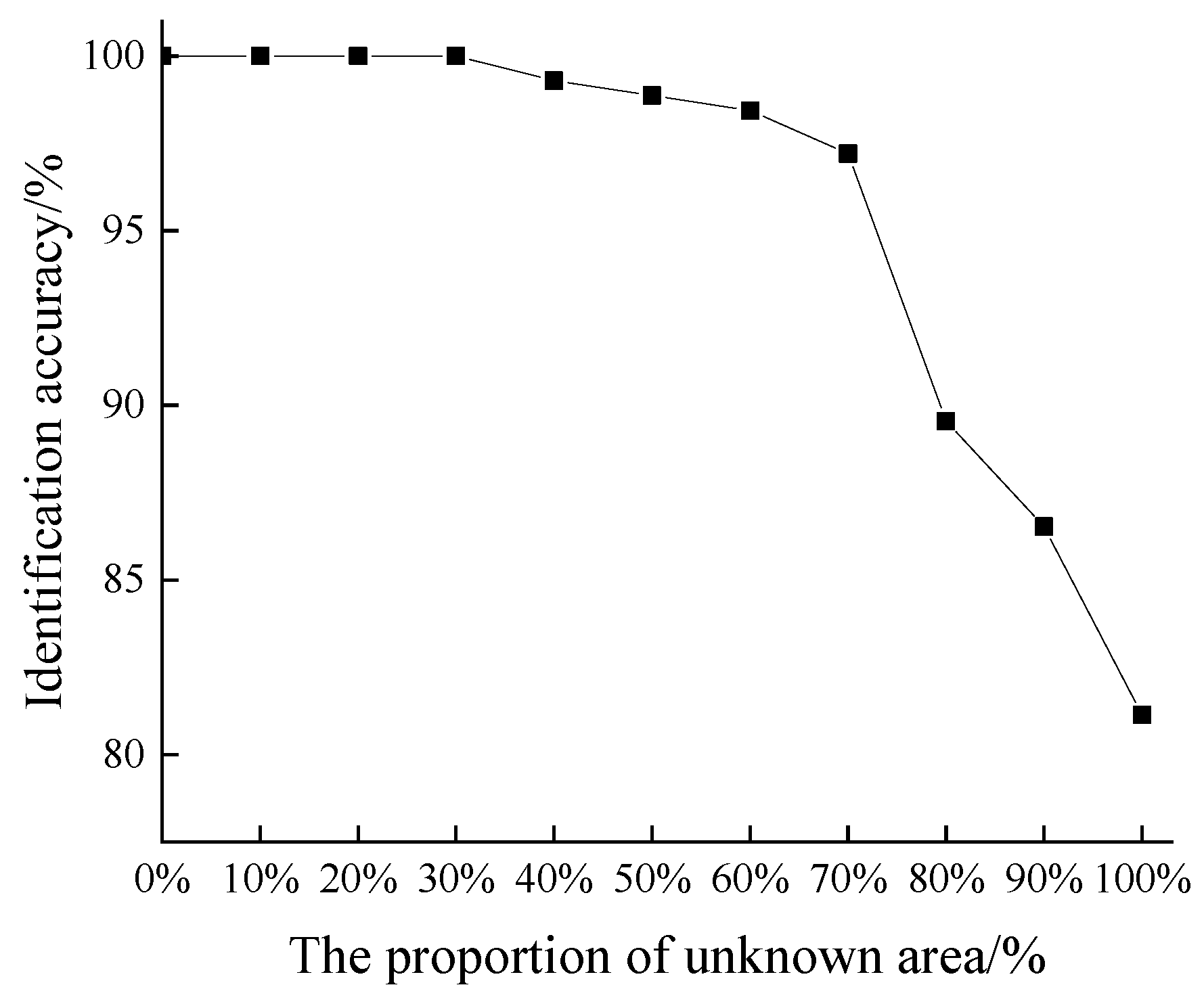
| Vertex | Vertex of Connection | Edge of Connection | Mapped Line |
|---|---|---|---|
| V1 | V3 | E1 | Transformer |
| V2 | V4 | E2 | Transformer |
| V3 | V1, V4, V5, V6 | E1, E3, E4, E5 | Line crossing point |
| V4 | V2, V3, V7 | E2, E3, E6 | Line crossing point |
| V5 | V3, V8, V9, V10 | E4, E7, E8, E9 | Line crossing point |
| V6 | V3, V11, V12 | E5, E10, E11 | Line crossing point |
| V7 | V4, V13, V14, V15, V16, V17 | E6, E12, E13, E14, E15, E16 | Line crossing point |
| V8 | V5 | E7 | L1 |
| V9 | V5 | E8 | L2 |
| V10 | V5 | E9 | L3 |
| V11 | V6 | E10 | DER1 |
| V12 | V6 | E11 | L4 |
| V13 | V7 | E12 | L5 |
| V14 | V7 | E13 | L6 |
| V15 | V7 | E14 | L7 |
| V16 | V7 | E15 | L8 |
| V17 | V7 | E16 | L9 |
| Coefficient of Association | Size of Correlation |
|---|---|
| 0.8–1.0 | Highly correlated |
| 0.6–0.8 | Strongly correlated |
| 0.4–0.6 | Medium degree of correlation |
| 0.2–0.4 | Weakly correlated |
| 0.0–0.2 | Absence of correlation |
| Method | Accuracy Rate % |
|---|---|
| k-means | 71.6 |
| PCA+ k-means | 81.5 |
| t-SNE+ k-means | 85.8 |
Disclaimer/Publisher’s Note: The statements, opinions and data contained in all publications are solely those of the individual author(s) and contributor(s) and not of MDPI and/or the editor(s). MDPI and/or the editor(s) disclaim responsibility for any injury to people or property resulting from any ideas, methods, instructions or products referred to in the content. |
© 2023 by the authors. Licensee MDPI, Basel, Switzerland. This article is an open access article distributed under the terms and conditions of the Creative Commons Attribution (CC BY) license (https://creativecommons.org/licenses/by/4.0/).
Share and Cite
Sun, L.; Chen, Y.; Du, Q.; Ding, R.; Liu, Z.; Cheng, Q. Topology Identification of Low-Voltage Power Lines Based on IEC 61850 and the Clustering Method. Energies 2023, 16, 1126. https://doi.org/10.3390/en16031126
Sun L, Chen Y, Du Q, Ding R, Liu Z, Cheng Q. Topology Identification of Low-Voltage Power Lines Based on IEC 61850 and the Clustering Method. Energies. 2023; 16(3):1126. https://doi.org/10.3390/en16031126
Chicago/Turabian StyleSun, Lingyan, Yu Chen, Qinjun Du, Rui Ding, Zhidong Liu, and Qian Cheng. 2023. "Topology Identification of Low-Voltage Power Lines Based on IEC 61850 and the Clustering Method" Energies 16, no. 3: 1126. https://doi.org/10.3390/en16031126
APA StyleSun, L., Chen, Y., Du, Q., Ding, R., Liu, Z., & Cheng, Q. (2023). Topology Identification of Low-Voltage Power Lines Based on IEC 61850 and the Clustering Method. Energies, 16(3), 1126. https://doi.org/10.3390/en16031126







